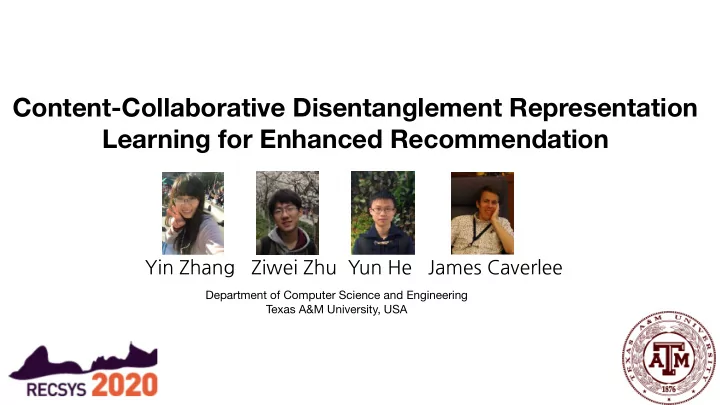

Content-Collaborative Disentanglement Representation Learning for Enhanced Recommendation Yin�Zhang���Ziwei�Zhu��Yun�He���James�Caverlee�� Department of Computer Science and Engineering Texas A&M University, USA
Collaborative features vs Content features Collaborative Filtering Content-aware Recommendation Dress content info Image, Descriptions, Reviews, … ? User content info Age, Jobs, Social Connections, …
What if we consider both Collaborative features and Content features? Item Content Information
What if we consider both Collaborative features and Content features? Many similar users prefer the dress because of: • Dress Appearances • Dress Price • Dress Quality Item Content Information The dress image is the known content information
What if we consider both Collaborative features and Content features? Many similar users prefer the dress because of: • Dress Appearances • Dress Price • Dress Quality Item Content Information The dress image is the known content information
What if we consider both Collaborative features and Content features? Many similar users prefer the dress because of: • Dress Appearances • Dress Price • Dress Quality Feature Duplication High Feature Correlation Item Content Information The dress image is the known content information
Collaborative features vs Content features Learning user preferences based on both content-based features and collaborative features can be problematic: Feature Duplication High Feature Correlation 1. Limiting the representation capability 2. Overweighting these correlated features Our Goal: Learn disentangled representations from user behavior data and content information
Disentangled Representation Learning • Aims to identify each feature that is relatively not influenced by other feature changes We want to learn the features: • shape; relatively not • color; influence each • object position; other changes https://ai.googleblog.com/2019/04/evaluating-unsupervised-learning-of.html • High quality representation; Robust performance; Interpretability • Commonly used method: statistically independent [1] [1] Chen, Ricky TQ, et al. "Isolating sources of disentanglement in variational autoencoders." Advances in Neural Information Processing Systems . 2018.
How to learn disentangled features from both content and collaborative information? Challenges 1. High heterogeneity between implicit features in user-item interactions and explicit features in content information Disentangled? 2. Granular-level disentanglement (disentanglement within features) Disentangled
How to learn disentangled features from both content and collaborative information? Challenges 1. High heterogeneity between implicit features in user-item interactions and explicit features in content information Disentangled? Collaborative features 2. Granular-level disentanglement Disentangled? (disentanglement within features) Disentangled Content features Disentangled?
Proposed Method: DICER We propose a novel two-level disentanglement approach called DICER – DIsentangling Content-aware collaborative filtering for Enhanced Recommendation – to learn disentangled features considering both content and collaborative features. It contain three steps:
Proposed Method: DICER We propose a novel two-level disentanglement approach called DICER – DIsentangling Content-aware collaborative filtering for Enhanced Recommendation – to learn disentangled features considering both content and collaborative features. It contain three steps: 1. Content-Collaborative disentanglement;
Proposed Method: DICER We propose a novel two-level disentanglement approach called DICER – DIsentangling Content-aware collaborative filtering for Enhanced Recommendation – to learn disentangled features considering both content and collaborative features. It contain three steps: 1. Content-Collaborative disentanglement; 2. Feature disentanglement at granular-level;
Proposed Method: DICER We propose a novel two-level disentanglement approach called DICER – DIsentangling Content-aware collaborative filtering for Enhanced Recommendation – to learn disentangled features considering both content and collaborative features. It contain three steps: 1. Content-Collaborative disentanglement; 2. Feature disentanglement at granular-level; 3. Co-decoders;
Proposed Method: DICER Content disentangled collaborative features: extracted from user-item interactions Content features: extracted from item content
Content-Collaborative Disentanglement User feedback x_i is generated from all the features z_i that influence user preference towards items: (1) We decompose z_i to be the content features derived from item content and the content disentangled collaborative features derived from user- item interactions: (2) We set the extracted features from the content and user-item interactions to be statistically independent
Feature Disentanglement Disentangle each extracted feature at a granular level —KL decomposition: penalizing mutual information statistical independence of ensure the learned latent through the information the learned latent representations in each dimension bottleneck can encourage representation in each are close to their corresponding feature disentanglement dimension of z^o under the priors condition of z^c
Experiments: Recommendation E ff ectiveness • DICER consistently outperforms state-of-the-art methods in recall@K and NDCG@K;
Experiments: Visualization of Content and Collaborative Disentanglement Clustered by user- oriented info Clustered by item content-oriented info • By content-collaborative disentanglement in DICER, the learned disentangled content feature representations and collaborative feature representations capture very di ff erent information;
Conclusions and Future Work • We study the relations between content features and collaborative features , and analyze the potential problem to consider both features at the same time ( feature duplication and high correlation ); • We propose a novel two-level disentanglement approach that supports both content-collaborative disentanglement and feature disentanglement based on the structure of a variational auto-encoder; • By considering the disentanglement between content features and collaborative features, the learned representations can capture di ff erent information and brings large improvement for recommendation. Future work: • Extending DICER to other scenarios, e.g., where a user’s social network is available.
Thank you! Content-Collaborative Disentanglement Representation Learning for Enhanced Recommendation Yin Zhang (zhan13679@tamu.edu)
Recommend
More recommend